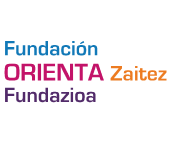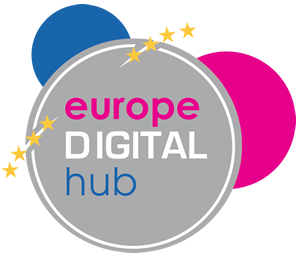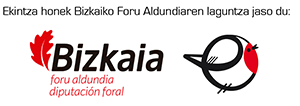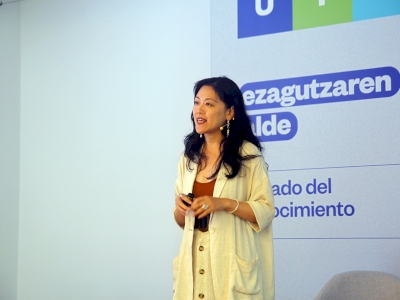+Trebakuntza

Initial Vocational Education: For social cohesion
The Minister of Education, Jokin Bildarratz, together with the Deputy Minister of Vocational Education, Jorge Arevalo, presented the new model of Initial Vocational Education - previously known as Basic Vocational Education - last February 9. This model has been designed by the Department of Education and will be launched from the 2024-2025 academic year in the Basque Vocational Education system. The presentation was made in a workshop of the Mendizabala Vocational Education Integrated School in Gasteiz.
It is a more flexible, adapted, open, accessible and efficient training model, and one of its most important pillars is social cohesion. The main goal of creating Initial Vocational Education is for students to continue learning, to continue training, even after obtaining a qualification. It was created so that no one is left behind, without a training path or without the possibility of continuing their studies, and it focuses in particular on the most vulnerable groups.
Social cohesion
Social cohesion and the well-being of society - being two of the main priorities of the Basque Government - require a large population that is properly trained, qualified and integrated, both socially and professionally. And the education system is extremely important in this matter. An advanced and cohesive society cannot leave anyone behind; because it is not good for those who are left out, and it does not benefit society in general.
At the end of the studies in this training model, students obtain two degrees (the Compulsory Secondary Education degree and the Basic Degree degree, and if they follow an integrated route, the Intermediate level as well), and also a professional certificate. The purpose of these qualifications is to acquire professional and employability skills, as well as lifelong learning skills.
Rather than closing its doors, Initial Vocational Education opens its doors wide so that students can continue their training journey.
For this reason, it facilitates connections with all qualifications in the education system. That is, at the end of this training, students can continue to study at Middle School, High School, High School and University.
Diversity of collectives
Initial Vocational Education is designed to cater to a wide range of students. He can pay attention to the following collectives:
z Students with practical abilities, skills and abilities: they will take the normal Vocational Education cycles of two academic years. The priority goal of these students will be to obtain a secondary school diploma, then to continue studying in a high school or intermediate training cycle.
z Students with learning difficulties: they will take the normal two-year cycle, but priority will be given to the basic degree. They will also be helped to obtain a secondary school diploma. This route will be aimed at professional exits, but students will be able to continue studying in the Intermediate training cycles. If they verify the qualification of the Intermediate Technician, they can then take a specialization course and/or enter an Advanced Training Cycle.
z People with functional diversity: they will do training cycles adapted to the curriculum. Cycles can last three academic years. Priority will be given to training cycles to make it easier to get a job and a suitable context for internships will be designed. The training will also provide the opportunity to learn through the flexible modular catalog, that is, with the possibility to do the modules in parts.
z People without qualifications but with work experience: aimed at adults who are working and who want to enter a professional training course, if they have not previously obtained the Competencies of Compulsory Secondary Education. Work experience will be verified through the competency verification structure. They will receive a very flexible training offer.
z The unemployed without qualifications: they will receive very flexible training - They will check their work experience, if any, through the competence verification structure, if this is related to the target sector of the training they will do. Priority will be given to training to make it easier to get a job.
z Migrants with certified training: they will request the requested validations and will complete the training cycle allowed by the validation. They will get the appropriate qualification.
z Migrants without certified training: their aim will be to obtain a profession. Learning will be done through the flexible modular catalog, and the training will be aimed at professional exits, but, if possible, they will be encouraged to continue their training.
Routes
To respond to these collectives, various Initial Vocational Education it will be structured in routes. They are:
z Integrated learning paths: the aim is to verify the qualifications of basic and intermediate degrees, through four years of structured training. They will also be strengthened with specialization courses and programs.
z Adapted learning paths: the duration will be two or three academic years, and they will have specific curriculum developments. They will be offered the opportunity to do the learning through the flexible modular catalog (the option to do the modules in parts), and they will receive basic skills adapted to practical environments.
z Professionalization routes: they promote specialization focused on specific professions or trades, and therefore these routes strengthen and adapt the curriculum related to the relevant profession. The goal is to obtain a technician's degree, specialist technician's, advanced technician's and professional master's degree.
z Itineraries to strengthen education: based on students' preferences and expectations, for students who have greater opportunities to learn in a more practical environment and to obtain Compulsory Secondary Education skills. Also for students who have obtained a basic or intermediate degree and have options to return to the general education system.
z Flexible learning paths: degrees, certificates and tailor-made programs will be included. Learning will be based on a flexible modular catalog. At the end of them, official qualifications and certificates will be verified.
Multimedia
Smart & Green Fundazioa Summer Courses from UPV/EHU
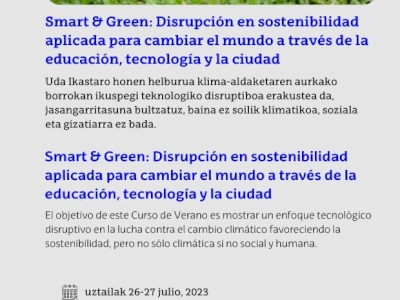
What are you waiting for? Sign up
Blockchain Conference La Rioja


